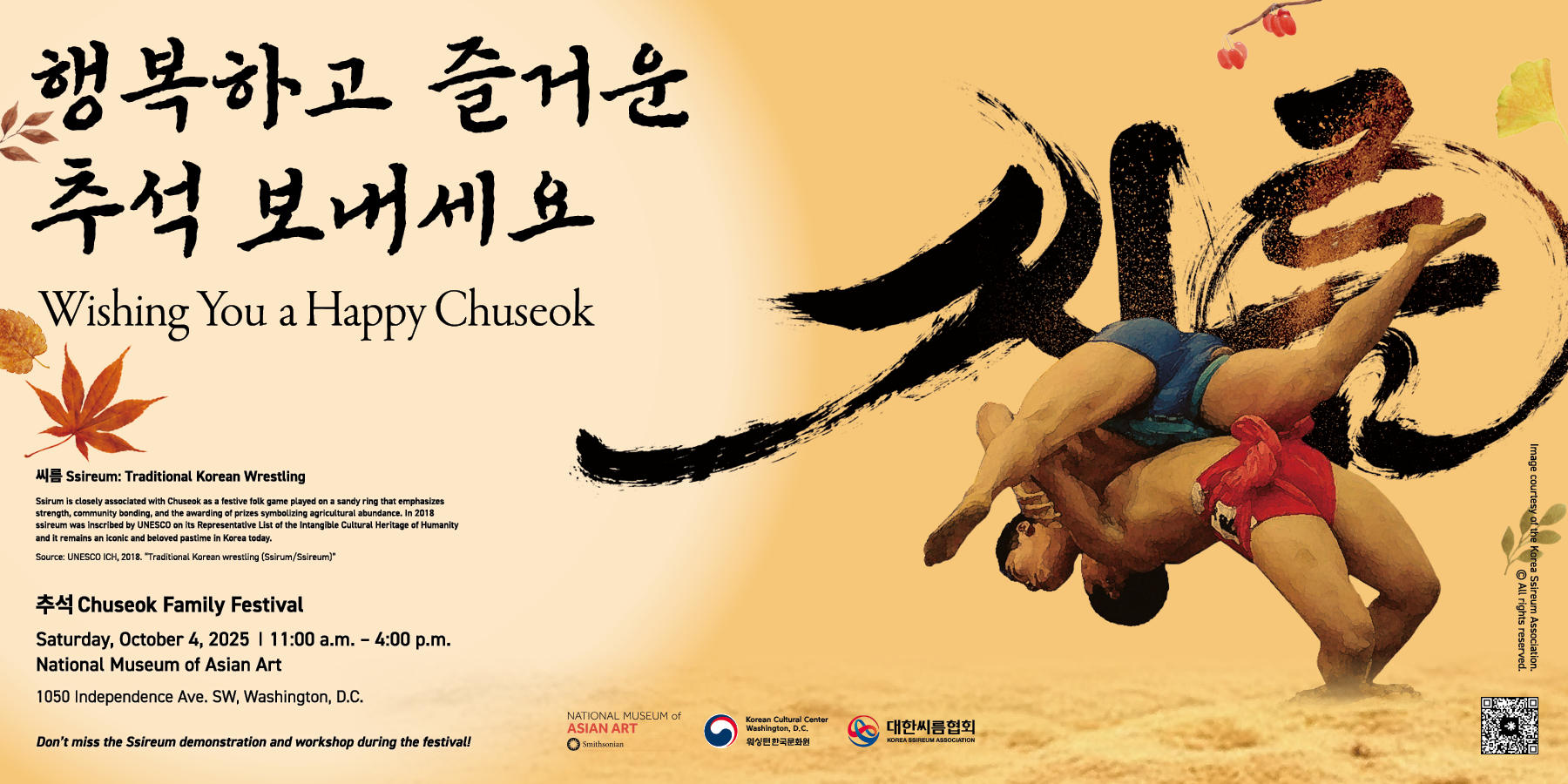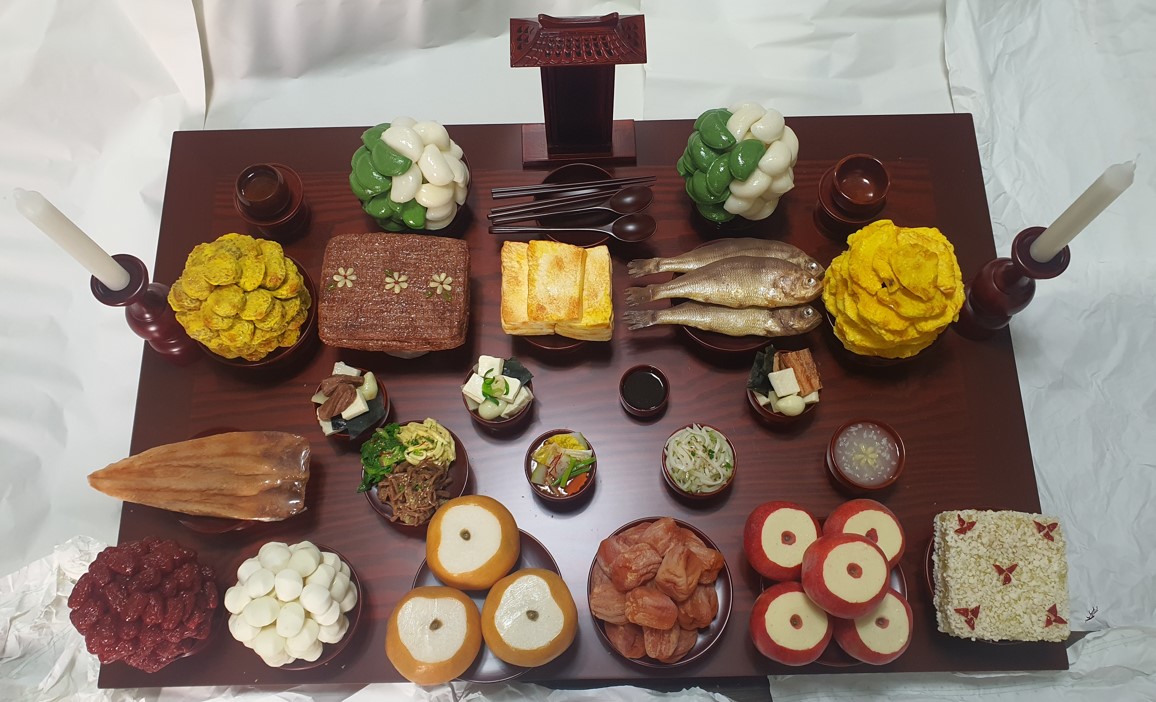EVENTS
2025 Chuseok Family Festival with the National Museum of Asian Art
- Post DateSep 03, 2025
- Hits527 Hit

Join the Korean Cultural Center Washington, D.C. (KCCDC) and the Smithsonian’s National Museum of Asian Art (NMAA) to celebrate one of Korea’s most important traditional holidays together at the 2025 Chuseok Family Festival on Saturday, October 4!
Now in its third year since starting in 2023, the festival has quickly become a signature program for the KCCDC and the NMAA, drawing more than 5,000–6,000 visitors of all ages for a full day of cultural experiences. This year’s highlight include a first-ever introduction and live demonstration of 씨름 (ssireum), Korean traditional wrestling, in Washington, D.C. presented by the Korea Ssireum Association, plus live traditional and K-Pop performances, dance workshops, Korean fashion photo booths, unique cultural heritage displays, and arts and crafts activities.
Chuseok (추석), also known as Hangawi (한가위) or more casually as Korean Thanksgiving, is one of Korea's most important and beloved holidays. For many Koreans it is a time to journey home, reconnect with family and loved ones, and to give thanks for life’s blessings. Chuseok traditionally falls on the day of the largest full moon according to the lunar calendar, signaling the end of the harvest season and a time to relax while thanking one’s ancestors for the season’s abundance. For more on Chuseok and its rich traditions, scroll down below.
Don’t miss this chance to immerse yourself in the exciting and heartwarming traditions of Korea’s beloved autumn holiday that’s all about family, fun, and connection: Chuseok!
Chuseok Family Festival
Saturday, October 4, 11:00 AM - 4:00 PM
The Smithsonian National Museum of Asian Art
1050 Independence Ave. SW Washington, D.C.
MORE INFORMATION & REGISTRATION ON THE NMAA WEBSITE!
HIGHLIGHTS
Presented by the KCCDC
Ssireum: Traditional Korean Wrestling presented by the Korea Ssireum Association
Location: Gallery 30, East Building (Arthur M. Sackler Gallery)
Photo Display: 11:00 a.m. – 4:00 p.m.
Demonstration Matches: 11:00 – 11:20 a.m., 12:30 – 12:50 p.m., 2:30 – 2:50 p.m.
Hands-on Workshops:* 11:30 a.m. – 12:30 p.m., 12:50 – 2:00 p.m., 2:50–4:00 p.m.
*Workshop particpants will be selected through an on-site raffle and required to sign a safety waiver, per museum regulations. Participation may be limited.
K-Pop Music and Activities
Location: Freer Plaza (West Building Plaza)
Featuring music sets by DJ Taeon Lee, performances and workshops by N2 Studios, and music throughout the day, 11:00 a.m. – 4:00 p.m.
Traditional Music & Dance
Location: Meyer Auditorium, West Building
Korean Traditional Dance & Drumming by Di Dim Sae Korean Traditional Art Institute
1:30 – 2:00 p.m.
Presenting Giwonmu (Ritual Dance), Mega Drum Performance, Burna Spin, Hwaraengi Chum (solo dance), and Samgomu (Drum Dance), under Director Soo Kyung Jung
Samulnori Traditional Percussion Ensemble by Washington Samulnori
2:10 – 2:40 p.m.
Presenting Samdo Sul Changgo Garak and Samdo Nongak Garak, under Director Sebastian Wang
Korean Folk & American Old-time Fusion with Global String Band JOOL
3:00 – 3:40 p.m.
Featuring Yoona Kim and Sammy Wetstein, and the Korean ajaeng (bowed zither)
Cultural Displays & Activities
All day 11:00 a.m. – 4:00 p.m.
Life Size Charye (차례) Ancestral Rites Table
Location: West Building (Freer Gallery of Art), North Corridor
Korea Ssireum Association Photo Display
Location: East Building (Arthur M. Sackler Gallery), Gallery 30
Crafts, Coloring Activities & Traditional Fan Decorating
Location: West Building, South Corridor
Hanbok (한복) Traditional Korean Clothing Photo Booth
Location: East Building, Gallery 27 (Flex Space)
Additional programs presented by the NMAA can be found on their website!
This event is co-presented by the Korean Cultural Center Washington, D.C., the Korea Ssireum Association, and the National Museum of Asian Art. Generous support is provided by the National Museum of Korea.
ABOUT CHUSEOK
Chuseok (추석), also known as Hangawi (한가위) or simply referred to as Korean Thanksgiving, is one of Korea's most important and beloved holidays. For many Koreans it is a time to journey home, reconnect with family and loved ones, and to give thanks for life’s blessings. Traditionally it is on the 15th day of the 8th month of the lunar calendar, which in 2024 falls on September 17. Chuseok literally means “autumn evening” and originates with agricultural society as a celebration of the harvest coinciding with a full moon. The holiday’s other name, Hangawi, also means “great ideas of autumn.” According to the lunar calendar, the largest full moon of the year appears on this day, signaling the end of the harvest season and a time to relax while thanking one’s ancestors for the season’s abundance.
Today, many families still gather to share food, games, and fond memories during Chuseok, wherever they live. Many families also maintain the tradition of holding a ritual of thanks with newly harvested crops, expressing their appreciation to their ancestors and to nature itself. Just like Thanksgiving and other harvest festivals worldwide, Chuseok is a blissful time to reconnect and be grateful for all of life’s blessings. As the Korean saying goes, “No more, no less—may it always be perfect like Chuseok” (더도 말고 덜도 말고 한가위만 같아라).
In Korea, the day before and after are also typically part of the public holiday, allowing people to travel to their ancestral hometowns and be with family. A traditional Chuseok feast includes an array of treats and delicacies, including half-moon shaped rice cakes known as Songpyeon (송편), deep-fried, honey-soaked wheat confections known as Yakgwa (약과), savory pancakes of meat, fish, or vegetables known as Jeon (전), and herb-infused rice wine known as Baekju (백주) or newly-made rice liquor known as Shindoju (신도주).
Chuseok is also often marked by other important cultural traditions. During Charye (차례), the family visits their ancestral gravesite for Seongmyo (성묘), to bow and present a symbolic offering of favorite foods or drink, usually accompanied by Beolcho (벌초), the act of tidying up the gravesites by removing weeds to maintain a cared-for appearance, perhaps while wearing traditional Hanbok (한복) clothing.
ABOUT CHARYE (차례)
What is Charye?
Fundamentally, Charye is a way to remember, thank, and honor one’s ancestors, as well as to invite their continued blessings. Akin to an intimate memorial service or rite, it is often performed in the home during Seollal (Lunar New Year's Day), Chuseok (Korean Thanksgiving Day), and other traditional holidays. The Charye tradition centers around the Charye table; an array of foods are lovingly prepared by family members and displayed on the table, which also serves as a place to pay one’s respects with a formal bow. Traditional holidays in Korea often include merrymaking and family fun, but the presence of the Charye table is a quiet reminder that today’s blessings are made possible thanks to one’s ancestors.
Who performs Charye?
Charye is a tradition that brings together all members of the family and extended family, each of whom has a chance to briefly offer their respects with a formal bow. Traditionally and when possible, the family's eldest son and his eldest son host the Charye table itself.
Where is Charye held?
If a family has a dedicated ancestral shrine site, Charye would likely take place there. Otherwise, the Charye table would be set up in the main room of the home. Different families and regions in Korea may have their own Charye traditions.
How is Charye held?
The constraints and pace of modern life can often impede time-honored traditions, but Koreans will generally make a good faith effort to meet the requirements of a proper Charye as best they can. After all, Charye is as much or more about one’s pure sentiment and good intentions as it is about adhering to protocol. While not an explicitly religious tradition in the Western sense of the word, Charye nonetheless has an important spiritual aspect.
Traditionally, one prepares prior to Charye by keeping the mind and body clean for three days. On the morning of, the room housing the Charye table is purified with a brief ritual. Then, under the supervision of the lady of the house, particular foods are prepared for display, including soups, tteok (rice cakes), and jeon (savory pancakes). Meanwhile, male members of the household prepare a written invocation, memorial tablets, ritual vessels, and meat and fruits, all to be included on the table. When it is time to hold the Charye ceremony, the table is carefully set according to tradition with a folding screen behind it. The table also includes a small cup for sul (traditional liquor).

Elements of the Chuseok Charye Table
Charye tables can vary depending on region and family. However, an important foundational principle is Jinseol, or the proper directional arrangement of dishes according to their essential nature: for example, fish in the east and meat in the west, sweet sikhye drink in the east, and jujubes, chestnuts, pears, and persimmons arrayed from west to east. Some foods will appear in arrangements that contradict traditional Korean dining etiquette, indicating the table’s otherworldly significance. The table often features five rows of food items in total, all of which can take significant time to prepare by hand. The table itself also faces south, so that those taking part can face north.
The names of deceased family members are written on traditional Hanji paper and placed at the head of the table just in front of the screen to represent those ancestors’ spirits. Essentials like rice, soup, rice cakes, utensils, and liquor cups are placed in the first row just beyond the inscriptions; while Koreans universally eat with their rice bowls to the left of their soup bowls, here the rice is placed to the right of the soup—the proper position for those in the spirit world. During Chusoek, rice and soup will be replaced with Songpyeon, a traditional filled rice cake that resembles a half-moon.
The next row usually features beef and fish dishes, while the third row typically has three soups, each with a different base: beef, seafood, and tofu. The fourth row has dried fish on the left, sikhye at the opposite end, and vegetable side dishes in between. The last row is for sweets like fruit, nuts, and traditional confections; dates, chestnuts, pears, and persimmons are placed in this order from the left. Yakgwa (deep-fried, wheat-based cookies) and hangwa (airy and crunchy rice cookies) are on the right. Interestingly, peaches and red beans are never offered during these ceremonies as they are symbolically used to ward off spirits in other contexts—the opposite of the intention of the Charye table.
To learn more about Charye at Korean traditions, visit the National Folk Museum of Korea, the Korean Culture and Information Service, and Korea’s main information website, Korea.net.
